Q4 GDP 2010 was revised down to 2.8%, from the 3.2% advance report. The strong downward revision is a result of more imports coming into the U.S. than originally estimated, a reduction in government expenditures and a smaller reduction in personal consumption expenditures. Here is the original BEA GDP release.
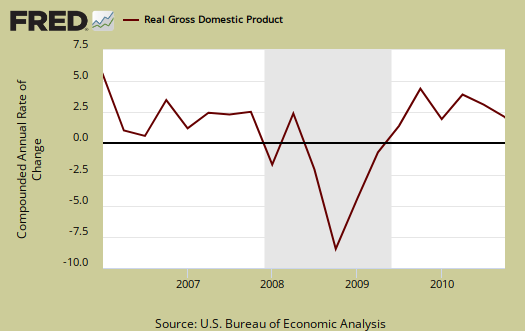
For the entire year, GDP increased 2.8% in 2010. This is in comparison to -2.6% annual GDP growth for 2009. Q4 GDP increased 2.7% in comparison to the 4th quarter of 2009. Below is annual real GDP, going back to the 90's. As you can see, we ain't roarin'.

One thing to note is energy and food inflation clearly increased, from the price indexes reported, in Q4 2010. Real GDP, which is 2.8% for Q4 2010, has had inflation removed. This is what real means in economic measurements.
The price index for gross domestic purchases, which measures prices paid by U.S. residents, increased 2.1 percent in the fourth quarter, the same increase as in the advance estimate; this index increased 0.7 percent in the third quarter. Excluding food and energy prices, the price index for gross domestic purchases increased 1.2 percent in the fourth quarter, compared with an increase of 0.4 percentin the third.
As a reminder, GDP is made up of:
where
Y=GDP, C=Consumption, I=Investment, G=Government Spending, (X-M)=Net Exports, X=Exports, M=Imports*.
Here is the Q4 2010 2nd revision breakdown of GDP percentage points:
- C = +2.88
- I = –3.13
- G = –0.31
- X = +1.18
- M = +2.17
Here is the Q4 2010 advance report breakdown of GDP by percentage point contributions:
- C = +3.04
- I = -3.20
- G = -0.11
- X = +1.04
- M = +2.40
Below are the percentage point differences, or spread between the advance and the second revision Q4 2010 GDP report components. This represents the change of gross domestic product growth contributions from Q4 advance to Q4 second revision.
- C = -0.16
- I = +0.07
- G = -0.20
- X = +0.14
- M = -0.23
Changes in private inventories did not vary from the advanced report, still a nose dive -3.70 percentage points from the change in Q4 GDP. Private businesses increased inventories $7.1 billion in Q4, following annualized real dollar amount increases of $121.4 billion in Q3 and $68.8 billion in Q2 2010.

Below are real final sales of domestic product, or GDP - inventories change. This gives a better feel for real demand in the economy. This is the worse news of this GDP release revision, it shows real demand was revised to 6.7% from 7.1% in Q4, so more slack in the economy. Could be worse, Q3 real demand was at 0.9%, or on life support.
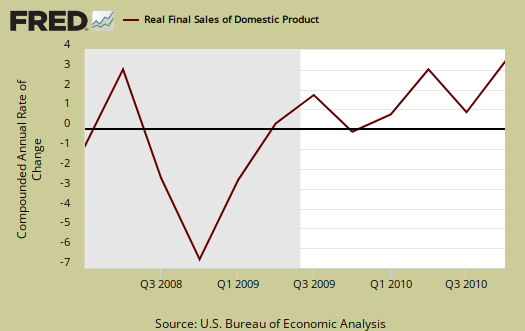
Below the the St. Louis FRED graph for C, or real personal consumption expenditures of the above GDP equation. As we can see from the above, while PCE, or C in the above equation, was revised down, it is still a fairly dramatic 42% increase in comparison to Q3's PCE contribution of 1.67 GDP percentage points.

Below is the breakdown in C or real PCE annualized change. Notice when times are tough, durable goods (bright red) consumption drops. Notice the increase in durable goods this quarter and Durable goods personal consumption was +1.44, revised from +1.48, percentage points of GDP. I'd claim durable goods implies the public thinks the economy is improving.

You might ask yourself how Imports could possibly add to GDP growth, when the United States runs a monthly trade deficit and imports subtract from GDP. It's due to the change, not the actual absolute deficit totals, which are absurdly high. When imports decelerate, that implies, per that quarter, more domestic goods and services were utilized to generate the changes in the rest of the GDP components. Therefore a deceleration in the trade deficit actually makes a positive contribution to GDP change. Keyword here is change, or growth, versus absolute totals. It's very similar to deceleration of private inventories negative affect on GDP.
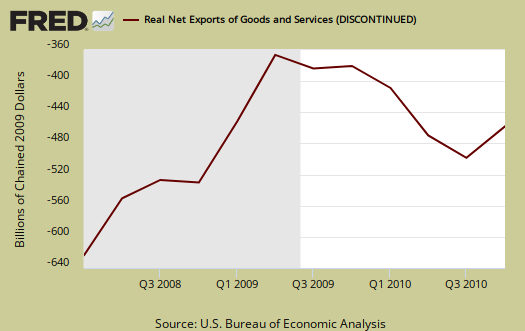
The below graph is real imports vs. exports. While exports increased, it is the trade deficit that matters.
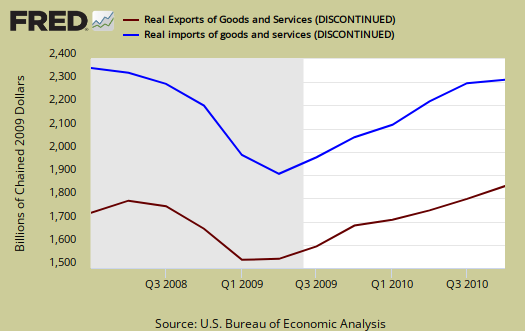
Below are the 2nd revision percentage changes of Q4 2010 GDP components in comparison to the 3rd revision Q3 2010 GDP report:
- C = +4.1%
- I = -22.1%
- G = -1.5%
- X = +9.6%
- M = -12.4%
Below are the advance report percentage changes of Q4 2010 GDP components in comparison to the 3rd revision Q3 2010 GDP report. These numbers are no longer valid, they are purely to compare against the 2nd revision report to see what changed by economic element.
- C = +4.4%
- I = -22.5%
- G = -0.6%
- X = +8.5%
- M = -13.6%
So, as you can see imports increased more than the advance Q4 estimate. Although exports also increased, it was not nearly enough to deal with the never ending imports into the country. Government spending also negatively impacted the revision. See, government does matter in terms of adding to economic activity and growth.
Motor Vehicles was revised, subtracting -0.31, (versus -0.34 advance) percentage points from Q4 real GDP while computer final sales added +0.30 percentage point changes. This is different from personal consumption, or C auto & parts. Motor vehicles are bought as investment, as fleets by the government and so forth and in Q4, they plain didn't buy much, instead opted for computers. For example in private investment, transportation equipment contributed -0.24 percentage points to Q4 GDP.
Residential fixed investment added +0.06 percentage points to Q4 GDP after subtracting off -0.75 percentage points in Q3 and being revised downward 0.02 percentage points for Q4. Below is the raw totals on residential investment. If one could ever see the housing bubble and then it's collapse in terms of economic contributions, the below graph is it. Residential fixed investment is only 2.8% of this quarter's GDP growth.
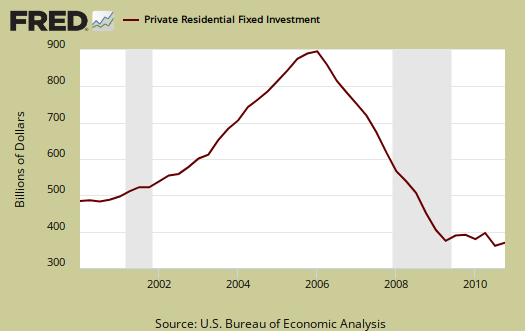
Real Gross Domestic purchases, which is whatever people in the U.S. bought, regardless of country of origin, decreased -0.6%, revised from -0.3%, in comparison of a 4.2% increase in Q3 2010.
Here are the graphs from Q4 2010 GDP, advance report.
The original BEA report pdf is attached to this post, for examining original data after it has been revised is difficult to locate.
Subject Meta:
Forum Categories:
| Attachment | Size |
|---|---|
| 145.19 KB |

GDP 2nd revision, did you pick up on government spending?
Anyone notice the second worse detraction from Q4 GDP was the reduction in state and local government investment and expenditures?
So, in other words, when people are laid off and governments reduce economic activity, that negatively impacts GDP.
It's #2 here in terms of the difference between revisions.
Also, GDP will be revised at least one more time and this is not a conspiracy, what happens is economic data dribbles in, plus the advance report has some outright estimates on the last month in it.
This is?
# G = –0.31 Excellent post. It is so comprehensive, I actually feel informed.
Michael Collins